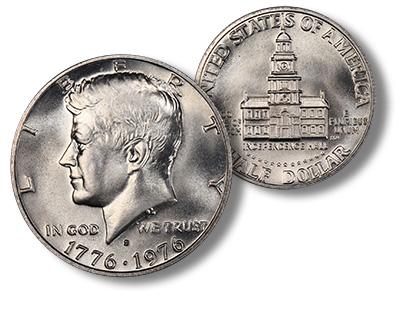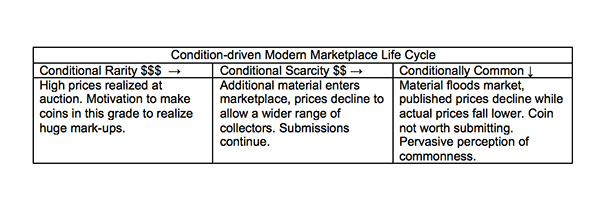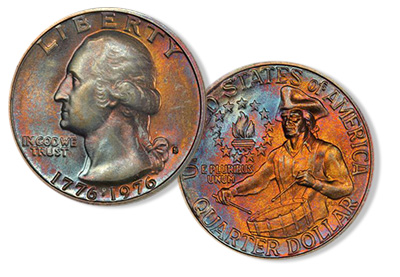
By Charles Morgan and Hubert Walker for CoinWeek …..
One of the first pieces that we wrote for CoinWeek discussed Bicentennial quarters. In it, we discussed the nuances of the issue, from strike to Mint State grade distribution of the P- and D-mint coins by PCGS and NGC. We also questioned whether the coin would ever see an appreciable rise in value (spoiler alert: it hasn’t yet). Regardless, when we wrote it, we felt that modern coin collectors would benefit from the kind of in-depth analysis that is generally reserved for “investment-grade” classic numismatic coins.
Today, we’d like to return to the topic of America’s Bicentennial coinage and discuss the silver-clad three coin Uncirculated set – a perennial favorite for collectors of modern U.S. coins.
The Bicentennial Silver Three-Coin Uncirculated Set was struck starting in February 1975 and continuing through to June 22, 1976, according to Walter Breen[1]. Q. David Bowers writes in his A Guide Book of Modern United States Dollar Coins that federal law required the U.S. Mint to be finished with silver Bicentennial coin production by July 4 of that year. As the production window closed, the Mint (expecting huge demand) made the decision to dramatically increase the number of sets made by running the coins through at high speed.
They probably shouldn’t have bothered; it is estimated that of the 11 million sets produced, only 4,908,319 sets were sold.
Demand for the issue, which had an initial offer price of $9 ($7 in bulk), dried up soon after the Bicentennial celebrations came to a close, but that didn’t stop the Mint from offering the overproduced set in its annual catalog until the end of 1986[2].
At the $9 offer price, the Bicentennial Silver Three-Coin Uncirculated Set had a price of $38.41 when adjusted for inflation in today’s dollars. The current melt value of the three coins in the set (a 40% silver Eisenhower dollar, a 40% silver Kennedy half dollar, and a 40% silver Washington quarter) is $9.51. When the sets were initially offered to collectors in 1975-1976, the spot price of the included coins was roughly $2.76 ($11.78 adjusted for inflation)[3][4].
Of the total units distributed, an unknown but appreciable number of them have been melted over the years. The great silver bubble of 1979-1980 marked the first major melt of the issue, but the impulse to cull these low-value coin sets continues even into the present. Because of these undocumented losses, it’s impossible to really know how many intact sets remain but based on current demand there are more than enough to go around. Judging by a quick survey of prices paid/realized on eBay for the sets over the course of the past 30 days, it seems that collectors are willing to pay between $12 and $18 for the sets – with the typical price falling somewhere in the $13-$14 range[5]. Interestingly, this price is down more than 30% since the last time we studied the average price realized for this set in 2015.
Two Types of Collector Demand
There are two types of collector demand for modern coins: demand for raw coins (coins as issued) and demand for certified coins (coins graded by a third-party service like NGC or PCGS).
For raw coins, grade on uncirculated coins in original mint packaging (or even broken up and put in individual after-market coin flips or 2x2s) is of little consequence. Collectors typically prefer coins with good eye appeal, but will generally accept a complete set in its original packaging as sufficient for their needs. To this type of collecting, a Bicentennial Silver Three-Coin Uncirculated has a value of whatever the prevailing market price is for a complete set.
In other words, $13-$14, based on today’s market price.
For collectors who prefer certified coins, the “value” of the sets is much more nuanced because the goals of this collector are markedly different. Certified coin collectors seek to commoditize quality. This has its upsides and downsides. For scarce material, grade becomes important because coins can be more easily categorized and ranked in specialist censuses. When there are eight or 10 known examples of an issue in Mint State, for instance, it is important for dealers, the market and collectors to create order. That way, when the finest- or second-finest-known example of a coin that is rare in Mint State comes to market, it can be appropriately catalogued, advertised and considered.
The ability to create order is never rock solid. Grade is always a compromise and is imperfect by nature due to many factors. It’s imperfect because experts often disagree. It’s imperfect because the market has a built-in incentive to obfuscate in order to achieve better outcomes for sellers. And it’s imperfect also because the services have no way of knowing what happens to the coins they grade after they return them to the submitter. In other words, a third-party grading company’s population census is about as clunky as a county voter roll. You don’t know who died (which coins were cracked out) and you don’t know who moved (which coins were crossed over or upgraded).
So it goes without saying that even in discrete populations, over-reliance on population census data may result in bad analysis and poor purchasing decisions. For larger populations, additional consideration is required but seldom brought to bear. Has grading been consistent throughout the entire population? Have grading standards evolved over time? Is there sufficient market to sustain tiered pricing premiums for all grades throughout the spectrum? How many collectors exist or can potentially exist in the market when it comes to the highest-priced grades? How many additional high-grade pieces can be made before the current pricing levels recede? And how many collectors exist or potentially exist in the next grade down and so on and so forth.
For as hard as it is to maintain some semblance of market stability when it comes to rare coins, it’s even harder to maintain stability when it comes to conditionally rare coins in issues that are not rare at all. Such is the case with modern certified coins, and coins taken from sets such as the Bicentennial Silver Uncirculated Coin Set are especially ripe for what we call market exploitation. Due to the low price of the sets, dealers (even collectors) can acquire the sets in large volumes, cherry-pick for quality, and add significantly to the population census. With minimum grading (where the service agrees not to grade or charge for coins that fall below a certain designated grade), the census reports skew towards higher-quality coins, which in essence increases the Terminal Grade (the lowest grade that a certified coin can have and still be profitable to the submitter) and diminishes the value of all the coins above and below.
The Terminal Grade for each of the coins in this set is the same: MS67.
In 2015, the PCGS Top Pop population for the coins in this set were: 462 MS68 1976-S Eisenhower dollars, one MS69 1976-S Kennedy half dollar, and two MS69 1976-S Washington quarters. Today, PCGS Top Pop populations stand at 785 MS68 dollars (a 70% increase), no change at the top for the Kennedy half dollar, and three MS69 Washington quarters (a 50% increase, but that’s almost meaningless since it refers to just one additional coin).
When we compiled our initial data in 2015, we did not include NGC populations so we cannot show growth. But today, the service’s population census indicates 96 MS68 dollars, 24 MS68 half dollars and one MS69 quarter.
1976-S Eisenhower Dollar
 As Charles told Q. David Bowers when he was writing Modern United States Dollar Coins, the 1976-S Eisenhower dollar is a coin that will generally grade out at MS67, when struck with care, and MS65 or MS66, when it was not. The slower, more careful run of coins is easily discerned by the “look” of the coin and the presence of a white stripe on the original package. Collectors looking for raw examples should avoid any set that does not have this white stripe, as that indicates coins struck using the high-speed process. A 1976-S Eisenhower dollar in MS68 is uncommon, but it is also a tricky grade.
As Charles told Q. David Bowers when he was writing Modern United States Dollar Coins, the 1976-S Eisenhower dollar is a coin that will generally grade out at MS67, when struck with care, and MS65 or MS66, when it was not. The slower, more careful run of coins is easily discerned by the “look” of the coin and the presence of a white stripe on the original package. Collectors looking for raw examples should avoid any set that does not have this white stripe, as that indicates coins struck using the high-speed process. A 1976-S Eisenhower dollar in MS68 is uncommon, but it is also a tricky grade.
We consider it a grade-within-a-grade, with both high-end and low-end examples. Some low-end specimens are undoubtedly over-graded MS67 coins, but others are likely technically correct coins with mediocre characteristics. A great 1976-S, of which we’ve seen only a few, will have plus plus luster, a firm strike from a die in early die state and minimal abrasions (the obverse and the reverse of the coins offer little in the way of abrasion that hides design elements).
Charles once owned a coin that he thought should be in an MS69 holder, but after repeated tries it was not to be[6]. No coin at either service has broken out of MS68 or earned an MS68+. A serious specialist will pay more for a premium MS68. The market has shown a willingness to pay $330-$350 for a CAC-certified example, while your run-of-the-mill, sight-unseen MS68 tends to bring between $250 and $290 (against a PCGS Coinfacts price of $350). Two years ago, a sight-unseen MS68 would likely trade for about $450.
The 1976-S Eisenhower dollar in MS67 is more typical for the date. Here, the average market price hovers in the $30-$40 range. Factor in the submission, shipping, acquisition and transactional cost of the coin and certified Eisenhower dollars are still marginally profitable at MS67. However, a seller would likely receive between $50 and $70 for the same coin two years ago.
1976-S Half Dollar
The top pop MS69 Kennedy half dollar was made several years ago by Eisenhower dollar researcher and Ike Group member Brian Vaile[7]. Amazingly, Brian found the coin in a set while looking for high-end Ike dollars and let it sit on his desk for more than a year before remembering to submit it. When it came back MS69, he was stunned. PCGS CoinFacts lists the coin as having a value of $7,500[8]. Vaile sold it several years ago to a collector for $6,000. I have no way of knowing what came of the coin after that transaction.
For the rest of us, the highest collectible grade is MS68. In MS68, PCGS shows a population of 416 pieces. Weirdly, NGC’s population for this issue is substantially lower in 68, with a paltry pop of 24. Chalk that up not to dramatically different grading standards but to submitter behavior. PCGS has certified 5,814 1976-S Kennedy half dollars over MS65, while NGC lags behind at 1,441.
 Two years ago, the typical price of an MS68 Kennedy half dollar was around $140. Recent pricing trends show a ridiculously wide variance of prices being paid for the coin, with some willing to pay Buy it Now prices as high as $100 to $150, but with auction prices realized falling in the range of $50 to $80. We’ve seen similar price variance in the American Silver Eagle market, where market knowledge agnostic buyers seem willing to pay exorbitant prices for coins that simultaneously sell for much, much less on the same day, on the same sales platform.
Two years ago, the typical price of an MS68 Kennedy half dollar was around $140. Recent pricing trends show a ridiculously wide variance of prices being paid for the coin, with some willing to pay Buy it Now prices as high as $100 to $150, but with auction prices realized falling in the range of $50 to $80. We’ve seen similar price variance in the American Silver Eagle market, where market knowledge agnostic buyers seem willing to pay exorbitant prices for coins that simultaneously sell for much, much less on the same day, on the same sales platform.
MS67 coins sell for between $15 and $25, making the coin virtually unprofitable for the submitter. Two years ago, this was a $50 coin.
Variety Hunters: There is a Doubled Die Obverse variety of the issue (FS-101) that carries a significant premium in certified grades. Worth a look; check out the latest edition of the Cherry Picker’s Guide for details.
1976-S Quarter Dollar
PCGS CoinFacts shows two public auctions for the 1976-S quarter in MS69 (both occurred in 2007). At that time, the PCGS MS69 population stood at two pieces. Three pieces are reported today against a PCGS Price Guide value of $7,500. Are they $7,500 coin today? Perhaps. Would they be $7,500 coins with a population of five? Doubtful. With the Eisenhower dollar series, the $1,000-coin threshold typically fell once certified populations approached 50 or 60 pieces. At the current rate, we may be unlikely to see the MS69 population approach the 50-coin mark, but a population of five or 10 pieces is certainly not out of the question.

Having said that, the 1976-S quarter is difficult to find in the wild in a condition that would earn the MS68 grade.
Two years ago, MS68 1976-S Washington quarters brought between $80 and $90. Today, one can be bought for between $50 and $60. MS68 is the Terminal Point for the issue, as the market price of the 1976-S quarter in MS67 is between $15 and $18. This is below the cost to buy the coin and submit it for grading. In 2015, Terminal Point was MS66.
Generally speaking, the silver-clad Washington quarter has a better look and strike than its clad counterpart. Again, better coins come in the white stripe envelopes and have a satin finish. Fast-struck  coins are bag marked and unattractive. Spectacular toners for the issue have turned up over the years. Some natural, some seemingly natural, and others quite obviously doctored. Approach this area at your own risk.
coins are bag marked and unattractive. Spectacular toners for the issue have turned up over the years. Some natural, some seemingly natural, and others quite obviously doctored. Approach this area at your own risk.
Collect or Invest? Raw or Certified?
Modern coin sets like these are riddled with problems and possibilities.
The problem with modern issues is that the market does not behave like it does for rare coins. Modern coins have a definite ceiling in terms of price performance, and the volume of coins in this segment, even high-grade certified coins, means that this material recycles often. Miss out on that 1976-S MS68 half dollar at the latest auction? Don’t worry, you can bid in an auction for one that ends later tonight, or tomorrow.
Because of this, collectors of certified examples of this issue need to ask themselves whether premium quality examples are worth the investment.
The possibilities lie in the fact that there is a constant influx of new collectors vying for these affordable coins. Modern coin collectors show a consistent willingness to spend up to $100-$120 for new coin releases (in silver) and $300-$500 for one-tenth to one-quarter ounce gold coins. A concerted effort in catering to these collectors or converting them to other areas of the hobby while staying within these price points seems like an obvious marketing strategy. We’ve often suggested that our colleagues show classic material side-by-side with modern fare in these price points. The problem, we are told, is volume. If it remains easier for mints to press new coins than it is for dealers to market old coins, then new coins will overtake the market. Seems like common sense to us.
Flip of a Coin
Of the two presidents represented on America’s bicentennial coinage who were alive when the Declaration of Independence was written, only Thomas Jefferson signed it. George Washington was not a delegate to the Second Continental Congress since Jefferson represented Virginia.
The silver-clad Bicentennial Eisenhower dollar features the Type I obverse and reverse. Most specialists know that the Mint altered the reverse, but subtle changes were made to the lettering and relief on the obverse as well.
The Bicentennial quarter has the largest mintage of any commemorative in U.S. history. The previous title holder? The 1952 Carver Washington commemorative half dollar, with a mintage of over two million coins.
* * *
Notes
[1] Breen, Walter. Walter Breen’s Complete Encyclopedia of U.S. and Colonial Coins. Doubleday, 1988. Print. 372.
[2] The United States Mint did put sales of the set on hiatus in 1979 and 1980, due to the run up on silver prices. Sales for the set resumed in August 1980, with a new price of $15 each.
[3] We use inflation data gathered from the United States Bureau of Labor Statistics online calculator: https://data.bls.gov/cgi-bin/cpicalc.pl
[4] Historic Comex Spot Price Settlement data: http://www.silverinstitute.org/site/silver-price/historical-prices/comex-spot-price/
[5] eBay prices surveyed include prices realized and “Buy it Now” offers from February 2017; outliers were excluded.
[6] Charles purchased the coin for $500 raw from a family member. It was a spectacular set that yielded a MS68 Eisenhower dollar, and a MS68 Kennedy half dollar, and a MS65 Washington quarter. The dollar and half dollar were PQ.
[7] Based on personal telephone conversations with Vaile in 2013.
[8] http://www.pcgscoinfacts.com/Coin/Detail/6728





Most likely the market has just about bottomed out on the silver bicentennial coinage
and will stay that way for a year or two. I foresee a slow but steady rise in value with
2026 the Semi-Quincentennial or as some prefer to call it Sestercentennial of America
bringing on high demand for the editions.